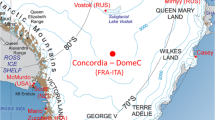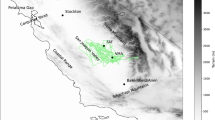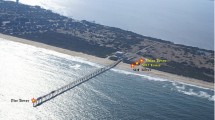Abstract
The winter-time arctic atmospheric boundary layer was investigated with micrometeorological and SF6 tracer measurements collected in Prudhoe Bay, Alaska. The flat, snow-covered tundra surface at this site generates a very small (0.03 cm) surface roughness. The relatively warm maritime air mass originating over the nearby, partially frozen Beaufort Sea is cooled at the tundra surface resulting in strong (4 to 30 °C · (100 m)-1) temperature inversions with light winds and a persistent weak (1 to 2 °C · (100 m)-1) surface inversion with wind speeds up to 17 m s-1. The absence of any diurnal atmospheric stability pattern during the study was due to the very limited solar insolation. Vertical profiles were measured with a multi-level mast from 1 to 17 m and with a Doppler acoustic sounder from 60 to 450 m. With high wind speeds, stable layers below 17 m and above 300 m were typically separated by a layer of neutral stability. Turbulence statistics and spectra calculated at a height of 33 m are similar to measurements reported for non-arctic, open terrain sites and indicate that the production of turbulence is primarily due to wind shear. The distribution of wind direction recorded at 1 Hz was frequently non-Gaussian for 1-hr periods but was always Gaussian for 5-min periods. We also observed non-Gaussian hourly averaged crosswind concentration profiles and assume that they can be modeled by calculating sequential short-term concentrations, using the 5-min standard deviation of horizontal wind direction fluctuations (Σθ) to estimate a horizontal dispersion coefficient (Σ y ), and constructing hourly concentrations by averaging the short-term results. Non-Gaussian hourly crosswind distributions are not unique to the arctic and can be observed at most field sites. A weak correlation between horizontal (Σ v ) and vertical (Σ w ) turbulence observed for both 1-hr and 5-min periods indicates that a single stability classification method is not sufficient to determine both vertical and horizontal dispersion at this site. An estimate of the vertical dispersion coefficient, Σ z , could be based on ΣΦ or a stability classification parameter which includes vertical thermal and wind shear effects (e.g., Monin-Obukhov length, L).
Similar content being viewed by others
References
Berkowicz, R. and Prahm, L.: 1982, ‘Evaluation of the Profile Method for Estimation of Surface Fluxes of Momentum and Heat’, Atmos. Environ. 16, 2809–2819.
Dalrymple, P., Lettau, H., and Wallaston, S.: 1966, South Pole Micrometeorology Program: Data Analysis, in M. Rubin (ed.), Studies in Antarctic Meteorology, American Geophysical Union Publication 1482, Washington DC.
Deacon, E.: 1973, ‘Geostrophic Drag Coefficients’, Boundary-layer Meteorol. 5, 321–340.
Draxler, R. R.: 1976, ‘Determination of Atmospheric Diffusion Parameters’, Atmos. Environ. 10, 99–105.
Guenther, A., Allwine, E., Bamesberger, L., Friedman, B., and Lamb, B.: 1988, ‘Dispersion Modeling in the Arctic’, Quality Assurance Final Report (CR812775) to ASRL-EPA, Research Triangle Park, NC.
Guenther, A., Lamb, B., and Petersen, R.: 1989a, ‘Modeling of Plume Downwash and Enhanced Diffusion near Buildings: Comparison to Wind Tunnel Observations for an Arctic Industrial Site’, J. Appl. Meteorol. 28, 343–353.
Guenther, A., Lamb, B., and Allwine, E.: 1989b, ‘Building Wake Dispersion at an Arctic Industrial Site: Field Tracer Observations and Plume Model Evaluations’, submitted to Atmos. Environ.
Hanna, S.: 1986, ‘Lateral Dispersion from Tall Stacks’, J. Clim. Appl. Meteorol. 25, 1426–1433.
Hanzlick, D., Schrader, G., and Hachmeister, L.: 1988, ‘Ice Breakup/Freezeup’, 1987 Endicott Environmental Monitoring Program, Envirosphere Co., Anchorage, AK.
Irwin, J.: 1979, ‘A Theoretical Variation of the Wind Profile Power-law Exponent as a Function of Surface Roughness and Stability’, Atmos. Environ. 13, 191–194.
Kaimal, J., Wyngaard, J., Izumi, Y., and Coté, O.: 1972, ‘Spectral Characteristics of Surface-layer Turbulence’, Quart. J. R. Meteorol. Soc. 98, 363–589.
Kaimal, J., Eversole, R., Lenschow, D., Stankov, B., Kahn, P., and Businger, J.: 1982, ‘Spectral Characteristics of the Convective Boundary Layer over Uneven Terrain’, J. Atmos. Sci. 39, 1098–1114.
Lamb, B. and Allwine, G.: 1986, ‘Vertical Meteorological Profiles and Wind Fluctuations in the Arctic Surface Boundary Layer’, Paper presented at 67th Annual Meeting of the Pacific Division, AAAS, Vancouver, BC.
Lumley, J. and Panofsky, H.: 1964, The Structure of Atmospheric Turbulence, Wiley-Interscience, New York.
Panofsky, H. and Dutton, J.: 1984, Atmospheric Turbulence, Wiley-Interscience, New York.
Pasquill, F. and Smith, F.: 1983 Atmospheric Diffusion, Ellis Horwood Ltd., West Sussex, England.
Rickel, C., Lamb, B., Guenther, A., and Allwine, E.: 1989, ‘An Infrared Method for Plume Rise Visualization and Measurement’, submitted to Atmos. Environ.
Sedefian, L. and Bennett, E.: 1980, ‘A Comparison of Turbulence Classification Schemes’, Atmos. Environ. 14, 741–750.
Vinnichenko, N., Pinus, N., Shmeter, S., and Shur, G.: 1980, Turbulence in the Free Atmosphere, Consultants Bureau, New York.
Walker, D. and Webber, P.: 1979, ‘Relationships of Soil Acidity and Air Temperature to the Wind and Vegetation at Prudhoe Bay, Alaska’, Arctic 32, 224–236.
Weller, G. and Holmgren, B.: 1974, ‘The Microclimates of the Arctic Tundra’, J. Appl. Meteorol. 13, 854–862.
Wexler, H.: 1936, ‘Cooling in the Lower Atmosphere and the Structure of Polar Continental Air’, Mon. Wea. Rev. 64, 122–136.
Author information
Authors and Affiliations
Rights and permissions
About this article
Cite this article
Guenther, A., Lamb, B. Atmospheric dispersion in the arctic: Winter-time boundary-layer measurements. Boundary-Layer Meteorol 49, 339–366 (1989). https://doi.org/10.1007/BF00123649
Accepted:
Issue Date:
DOI: https://doi.org/10.1007/BF00123649




